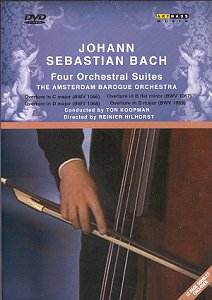Bach’s Orchestral Suites, or Overtures, are among the only true orchestral works he wrote for a chamber ensemble. With the exception of the Brandenburg Concertos, all his other orchestral works are for solo instruments, such as harpsichord or violin, and orchestra. The four overtures are tutti works, like the Brandenburgs, where the entire ensemble is the soloist. These works are also some of the most French of all of Bach’s music - not only is the sound distinctly French, but the movements bear French names as well.
Ton Koopman is one of the most interesting Bach performers in recent years. He is incredibly committed to performing and recording Bach’s music, and has, as a soloist, recorded all of Bach’s keyboard and organ music, and is currently in the midst or recording all of his cantatas. This DVD presents a recording of the four Orchestral Suites in the Het Loo Palace in the Netherlands, a beautiful baroque palace with striking decoration. Each suite is performed with different forces in a different location within the palace, adding a nice touch of variety to the film.
The performances are very good. They are lively, moving, full of vigour and they get the feet tapping, something that too many performers of these works cannot achieve. All too often these suites end up sounding staid and rigid, as conductors try and fit them into a mould that is more appropriate for Mozart or Haydn symphonies. This recording is full of fine contrasts as well. The spirited bourrée of the second suite is followed by a stately, rhythmic reading of the polonaise, a sensitive minuet, and an almost bouncy badinerie. (This suite is especially intimate, featuring only seven musicians, compared with about twenty for the third and fourth suites, and a dozen for the first.)
This is a delightful recording of the Orchestral Suites, full of energy and a true French spirit. While the camerawork is generally uninteresting - as is often the case for films of orchestral performances - the décor is attractive and the music is wonderful.
Kirk McElhearn


